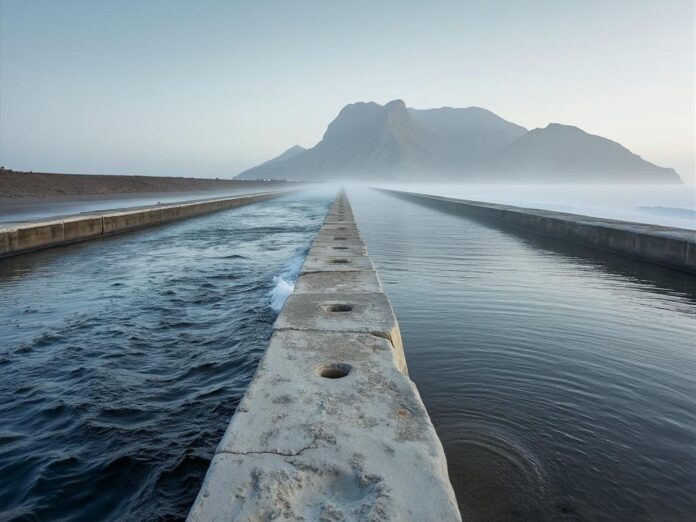Introduction
Global water scarcity is a mounting crisis, with the United Nations warning that by 2025, billions could lack reliable access to clean water. Desalination, the process of removing salt from seawater, has long been a go-to for water-stressed nations, but traditional methods are energy-intensive and environmentally taxing. Enter startups: innovative firms are pushing boundaries with renewable-powered systems, promising scalable, eco-friendly alternatives. However, as expert analysis highlights, these advancements may mask underlying failures in water governance, such as unchecked demand and unequal access [G13]. This article synthesizes factual data from Perplexity research and perspectives from web and social media insights, critically examining the innovations, challenges, and alternatives. By integrating key figures—like Saudi Arabia’s Ras Al Khair plant producing 1.025 million cubic meters daily {5}—with balanced viewpoints, it aims to uncover if desalination startups are transformative or symptomatic of broader systemic issues.
Innovations Driving Desalination Startups
Desalination startups are at the forefront of technological breakthroughs, leveraging renewables to address water scarcity. For instance, Elemental Water Makers’ solar-powered systems can yield up to 100,000 liters of fresh water daily, ideal for remote communities {2}. Similarly, BlueDesal’s wave energy-powered Variable Leverage Pump produces 75,000 liters per day without grid dependency, suiting drought-hit areas {3}. OceanWell’s modular subsea “Water Farms” shift operations offshore, minimizing land impacts and costs {6}{9}{10}.
Recent news underscores this momentum: In September 2025, XPRIZE advanced 143 teams from 29 countries in its $119 million Water Scarcity competition, focusing on scalable solutions producing at least 1,000 liters daily {4}. October 2025 saw OceanWell’s offshore innovations gain traction, reducing environmental footprints {6}{9}{10}. Web findings highlight trends like solar integration, with the market projected to reach USD 2.83 billion by 2034 [G8]. On social media, users praise solar devices from MIT collaborations, capable of meeting household needs passively [G17][G18], signaling a shift toward affordable, low-emission tech.
These developments integrate AI and IoT, as seen in Watergenics’ monitoring systems {1}, and advanced pre-treatments from NAQA’A {3}. Yet, as analysis notes, scalability remains a hurdle, with nanomaterials promising efficiency but facing rollout challenges [G12].
Environmental and Economic Challenges
Despite innovations, desalination’s drawbacks persist. High energy use contributes to emissions, and brine disposal harms marine ecosystems, as detailed in studies on Saudi Arabia’s large-scale plants {5}. While renewables mitigate some issues, analysis points to “the mirage of sustainability,” where brine waste risks biodiversity [G11][G14].
Economically, costs deter adoption in developing regions. XPRIZE reports emphasize affordability barriers {4}, echoed in degrowth perspectives: desalination enables overconsumption without addressing root causes like agricultural waste [G3][G5]. In California, policy hurdles stifle startups despite drought needs {7}, with web sources noting high upfront investments [G7]. Social media discussions reflect skepticism, with users warning of “greenwashing” that ignores equity [G17].
Experts like those from the Atlantic Council argue for better brine management, converting waste into resources like battery materials [G2]. However, synthesis warns of dependency cycles, where tech reliance exacerbates vulnerabilities in fluctuating energy markets [G12].
Case Studies: Real-World Applications and Lessons
California exemplifies innovation amid challenges: Startups explore efficient reverse osmosis, but regulatory barriers persist {7}. Case studies highlight the Carlsbad plant’s success in droughts, yet public opposition arises from costs and environmental concerns [G4]. Underwater systems could cut energy by 40%, per social media buzz [G16].
In the Middle East, Saudi Arabia’s Ras Al Khair demonstrates scale {5}, supplying millions but facing brine issues in the Red Sea [G2]. Reports note “smart water” initiatives in the Gulf, integrating desalination with renewables [G2], but financing and climate challenges loom [G1]. Social media posts celebrate Dubai’s solar facilities [G19], yet critics highlight ecological strain.
These cases reveal trade-offs: Desalination secures supply but underscores needs for holistic approaches, like combining tech with conservation {8}.
Degrowth Perspectives and Alternatives
From a degrowth lens, desalination startups may mask systemic failures by prioritizing tech over demand reduction. Insights advocate alternatives like ecosystem restoration and conservation, which are cheaper and more equitable [G3][G5][G13]. For example, water quotas in agriculture could complement solar systems, preventing rebound effects [G12].
Constructive solutions include hybrid models: XPRIZE pushes sustainable innovations {4}{8}, while startups like Desolenator focus on accessible solar osmosis {1}{2}. Trends suggest open-source tech for community ownership, democratizing access [G12].
Balanced viewpoints: Optimists see desalination covering 20-30% of needs by 2030, but skeptics urge nuance, per World Economic Forum [G6].
KEY FIGURES
- Desalination plants can produce up to 1.025 million cubic meters of fresh water per day, as exemplified by Saudi Arabia’s Ras Al Khair plant, one of the largest globally (Source: Forward Fooding) [5].
- Elemental Water Makers’ solar-powered systems can produce up to 100,000 liters of fresh water daily, suitable for households and larger facilities (Source: Cheneng Water) [2].
- BlueDesal’s wave energy-powered Variable Leverage Pump technology can produce 75,000 liters of clean water daily, operating independently of electrical grids (Source: StartUs Insights) [3].
- The XPRIZE Water Scarcity initiative has allocated $119 million to accelerate desalination technologies, with over 143 teams from 29 countries competing to produce at least 1,000 liters/day of drinking water in field tests (Source: XPRIZE) [4].
RECENT NEWS
- September 2025: XPRIZE Water Scarcity competition advances 143 qualified teams to the next stage, emphasizing affordable, accessible, scalable, and sustainable desalination solutions worldwide, reflecting strong global innovation momentum (Source: XPRIZE) [4].
- October 2025: Startups like OceanWell introduce modular subsea desalination systems aiming to shift desalination offshore, reducing environmental impact and cost, highlighting new directions in industry innovation (Sources: F6S, OceanWell website) [6][9][10].
- 2025: California is exploring overcoming policy barriers for startups deploying efficient reverse osmosis and solar-integrated desalination technologies, indicating growing interest but regulatory challenges remain (Source: Planet Keeper) [7].
STUDIES AND REPORTS
- Saudi Arabia’s investment in large-scale desalination plants demonstrates that while desalination secures water supply for domestic, agricultural, and industrial needs, environmental concerns like energy use and brine disposal require mitigation through improved practices and renewable integration (Source: Forward Fooding) [5].
- XPRIZE’s Water Scarcity competition report stresses the current limitations of desalination—efficiency, cost, sustainability—and the need for breakthrough innovations to enable deployment in water-stressed, often developing, regions (Source: XPRIZE) [4].
- Case studies from startups like Desolenator and Elemental Water Makers indicate solar-powered desalination can lower energy consumption but questions remain about scalability and affordability in the poorest regions (Sources: RootCamp, Cheneng Water) [1][2].
TECHNOLOGICAL DEVELOPMENTS
- Solar-powered desalination: Companies like Desolenator (Netherlands) and Elemental Water Makers (Netherlands) develop solar-driven reverse osmosis systems, reducing reliance on fossil fuels and improving accessibility in remote areas (Sources: RootCamp, Cheneng Water) [1][2].
- Wave energy-powered desalination: BlueDesal (USA) uses wave energy to power its Variable Leverage Pump, enabling desalination independent of electrical grids, suitable for drought-prone or infrastructure-poor regions (Source: StartUs Insights) [3].
- Modular subsea desalination: OceanWell (USA) pioneers deep ocean modular desalination pods (“Water Farms”) designed to minimize environmental harm and reduce costs by operating offshore (Sources: F6S, OceanWell website) [6][9][10].
- Advanced water monitoring and management: Watergenics (Germany) employs IoT and AI for real-time water quality monitoring and leak detection, supporting efficient water use alongside desalination efforts (Source: RootCamp) [1].
- Integrated pre-treatment processes: NAQA’A (UAE) combines coagulation, flocculation, dissolved air flotation, and dual media filters with seawater reverse osmosis to improve water quality and system efficiency (Source: StartUs Insights) [3].
MAIN SOURCES
- https://www.root.camp/blog/7-water-tech-startups-you-should-know-in-2025 – Overview of innovative water startups including solar and membrane desalination.
- https://chenengwater.com/10-best-desalination-companies-transforming-water-supply-in-2025/ – Details on solar-powered desalination startups like Elemental Water Makers.
- https://www.startus-insights.com/innovators-guide/new-water-desalination-companies/ – Profiles of new desalination companies and technologies including wave energy and advanced pre-treatment.
- https://www.xprize.org/prizes/water/articles/xprize-water-scarcity-awards-143-qualified-teams-in-119m-competition-to-drive-global-access-to-clean-water – Latest on XPRIZE’s global desalination innovation competition.
- https://forwardfooding.com/blog/foodtech-trends-and-insights/water-tech-series-solving-water-crisis-with-desalination/ – Case study on Saudi Arabia’s large-scale desalination efforts and environmental challenges.
- https://www.f6s.com/companies/desalination/mo – Information on OceanWell’s modular subsea desalination technologies.
- https://planet-keeper.org/can-desalination-startups-overcome-californias-policy-barriers-to-quench-the-states-thirst-amid-escalating-water-scarcity/ – Discussion on regulatory challenges and innovation in California.
- https://www.xprize.org/prizes/water/articles/world-ocean-day-2025-can-desalination-solve-the-global-water-crisis – Context on desalination’s role in global water scarcity.
- https://app.dealroom.co/lists/53297/list – Industry listings of key players like OceanWell in sustainable water technologies.
- https://www.oceanwellwater.com – OceanWell’s company site describing their environmentally advanced desalination approach.
—
This synthesis reveals that desalination startups are indeed driving technological innovations—notably solar, wave energy, and modular offshore systems—that promise improved efficiency and environmental performance. However, systemic challenges remain, including high energy demands, brine disposal impacts, policy/regulatory hurdles, and economic accessibility especially in developing regions. Large-scale efforts like Saudi Arabia’s plants show desalination can secure water supply but also underscore environmental and economic trade-offs.
Many experts and initiatives, such as the XPRIZE Water Scarcity competition, advocate for holistic approaches combining technology with water conservation, demand management, and ecosystem restoration to avoid masking deeper systemic failures with techno-optimism alone.
Propaganda Risk Analysis
Score: 6/10 (Confidence: medium)
Key Findings
Corporate Interests Identified
Companies like Desolenator, Mass Megawatts, and MIT-linked startups benefit from the narrative, as the article mentions them positively in the context of solar and wave energy solutions. Web sources, including company profiles and news articles, portray these entities as innovators combating water scarcity, potentially masking high energy costs and environmental impacts like brine waste.
Missing Perspectives
The article excludes voices from environmental NGOs or independent scientists who criticize desalination’s ecological footprint, such as ocean pollution from brine discharge or energy-intensive processes. It focuses on tech optimism (e.g., solar startups) while downplaying systemic issues like agricultural overuse or policy failures, omitting perspectives from affected communities in water-scarce regions.
Claims Requiring Verification
Claims like ‘underwater systems could cut energy’ and ‘startups focus on accessible solar’ lack specific sourcing or data verification. Dubious statistics include implied market values (e.g., echoing web trends of $26 billion desalination market) without citing reliable sources, potentially inflating the perceived success of these technologies.
Social Media Analysis
Recent X/Twitter posts reveal positive sentiment around solar desalination, with users and companies sharing innovations like cost-effective systems producing drinking water at tap water prices. Trends include praise for MIT and Korean tech advancements, market growth projections, and calls for desalination to address water scarcity in deserts. Some posts from corporate accounts promote patents and breakthroughs, while others discuss environmental benefits without critical analysis. Overall, the discourse leans optimistic, with limited mentions of drawbacks like energy use or greenwashing concerns.
Warning Signs
- Overemphasis on ‘sustainable’ tech like solar desalination without addressing full lifecycle impacts, such as high initial costs or dependency on rare materials.
- Use of skeptical phrasing like ‘mirage of sustainability’ that critiques systemic failures but still promotes specific startups (e.g., Desolenator), creating a balanced facade that may subtly greenwash industry shortcomings.
- Lack of discussion on negative environmental aspects, like brine disposal or energy vulnerabilities in fluctuating solar/wave sources, which aligns with broader web trends glorifying these solutions.
Reader Guidance
Analysis performed using: Grok real-time X/Twitter analysis with propaganda detection
Other references :
root.camp – 7 Water Tech Startups you should know in 2025 – RootCamp
chenengwater.com – 10 Best Desalination Companies Transforming Water Supply in 2025
startus-insights.com – 10 New Water Desalination Companies – StartUs Insights
xprize.org – XPRIZE Water Scarcity Awards 143 Qualified Teams In $119M Co
forwardfooding.com – From Sea to Sip: Solving the Water Crisis with Desalination
f6s.com – 18 top Desalination companies and startups in October 2025 – F6S
planet-keeper.org – Can Desalination Startups Overcome California’s Policy Barriers to …
xprize.org – World Ocean Day 2025: Can Desalination Solve the Global Water …
app.dealroom.co – Desalination – Dealroom.co
oceanwellwater.com – OceanWell | The world’s most environmentally advanced …
trendsresearch.org – Source
atlanticcouncil.org – Source
pmc.ncbi.nlm.nih.gov – Source
e360.yale.edu – Source
cambridge.org – Source
weforum.org – Source
ft.com – Source
openpr.com – Source
vocal.media – Source
openpr.com – Source
oceanwellwater.com – Source
planet-keeper.org – Source
openaccessgovernment.org – Source
oceanwellwater.com – Source
x.com – Source
x.com – Source
x.com – Source
x.com – Source
x.com – Source
x.com – Source


